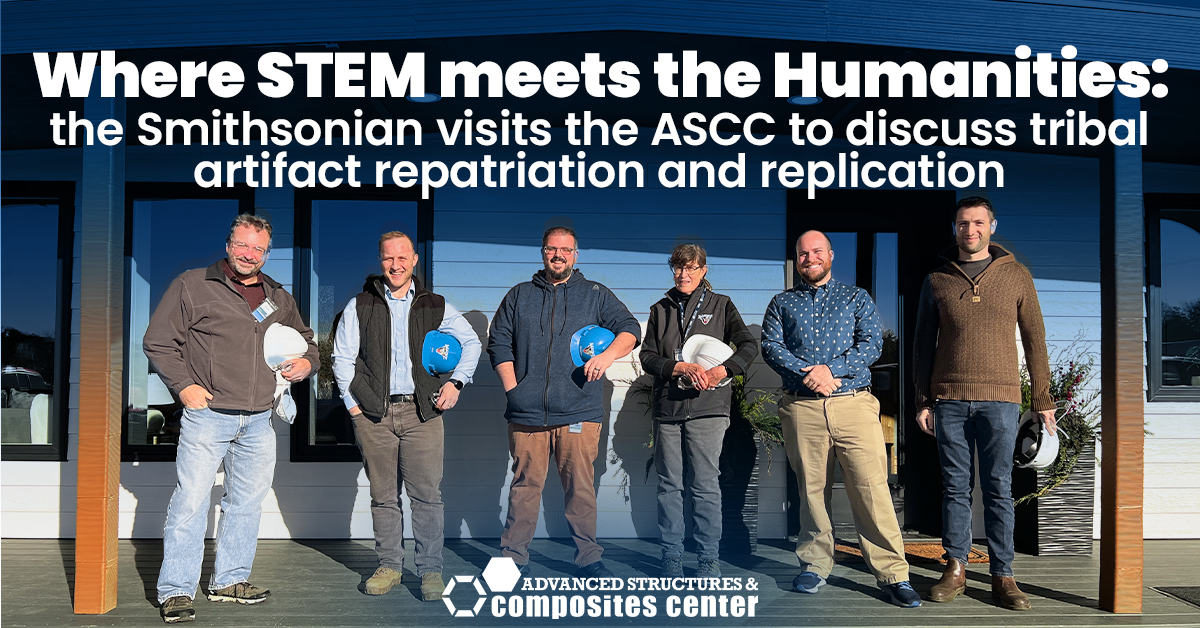
Where STEM meets the Humanities: the Smithsonian visits the ASCC to discuss tribal artifact repatriation and replication
Orono, Maine – In 2020, the Central Council of Tlingit and Haida Indian Tribes of Alaska requested that the University of Maine’s Hudson Museum return a 19th-century Tlingit frog clan helmet that was part of the museum’s collection. The Hudson Museum sought permission from Harold Jacobs, cultural resource specialist, to replicate the clan helmet prior to repatriating it. The Hudson partnered with researchers at the Advanced Structures and Composites Center (ASCC) to create a 3D-printed replica of the helmet and, with graduate students from the Intermedia Programs, to make the replica look like the original. To learn more about the Tlingit clan helmet project click here.
The innovative partnership between the Hudson Museum and the ASCC captured national attention from other cultural institutions, including the Smithsonian. Dr. Eric Hollinger, tribal liaison, Repatriation Office of the National Museum of Natural History, Smithsonian Institution, came to tour the ASCC and learn more about the project in December 2022. Hollinger had previously led a Smithsonian team in replicating similar objects for the Tlingit and other tribes. During the visit, ASCC structural thermoplastics research engineer Jonathan Roy walked Hollinger through a tour of the facilities to showcase the ASCC’s various material processing capabilities along with some of the major developments, such as BioHome3D.
Roy and Hollinger discussed the potential benefits of a partnership between the Smithsonian and the ASCC to connect tribes with technology that allows them to reclaim or restore cultural heritage through the use of 3D printing and milling technologies. The University of Maine is located in the homeland of the Penobscot Nation, and is committed to building ties with and supporting Indigenous communities.
Objects requested for repatriation may have been treated with pesticides and chemicals; others may have damage or missing elements. Some objects may be so fragile that handling or transportation may cause further damage. Creating 3D-printed replicas of artifacts in collaboration with tribes may allow museums to retain a copy of the object for exhibition and educational purposes and for tribes to reintegrate these objects into their community.
Hollinger’s work at the Smithsonian focuses on restoring the tribes’ authority over their cultural heritage and providing them with resources that help further the tribe’s goals how they see fit; replications can be made for tribes at their request, and at the request of the museums if the tribes support it. “We connect the community with the technology and let them decide what’s appropriate,” says Hollinger.
“It was a pleasure to host Eric during his visit to the University of Maine” says Roy. “During his visit, our team presented our design approach for the Tlingit Frog Clan helmet replication project to select the processes used to best match the replication criteria. Eric shared his breadth of knowledge on the current day best practices for artifact replication through repatriation projects, which was very enlightening. It was exciting to discuss opportunities for long-term collaboration on repatriation and replication projects and the ASCC has already begun discussing potential projects.”
The Advanced Structures and Composites Center has much to offer tribal communities in terms of such technology. Hollinger seemed particularly intrigued by the ASCC’s Ingersoll MasterPrint, the world’s largest 3D printer, for its use in replicating large scale objects such as canoes or poles that were previously considered too large for replication due to their size. Other capabilities of the ASCC were discussed in terms of supporting repatriation efforts, such as use of the thermoplastics lab in creating a lightweight and sturdy cavity packing for storing and transporting fragile objects of material culture. The ASCC is also specially equipped to handle digital information, providing safeguards to protect tribal intellectual property.
While 3D replicas are not the solution for every type of object, this partnership between STEM research and the Humanities appears to be bridging the two fields, leading to a positive future for academic research and for cultural heritage restoration efforts. Moreover, it represents the beginning of a new era of ethical and sustainable collaboration and the preservation and perpetuation of cultural heritage.
To read UMaine’s land acknowledgement, click here.
Contact: Josi Young, josina.young@maine.edu; Elizabeth Dalton, elizabeth.dalton@maine.edu
